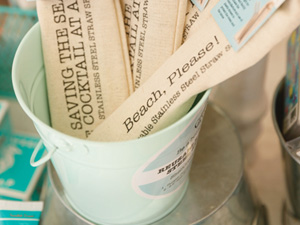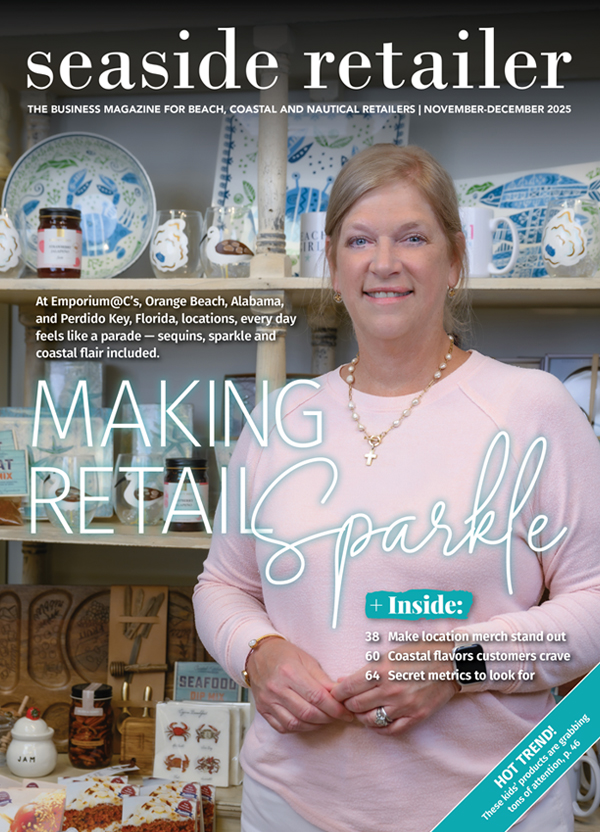When beachgoers and coastal residents walk into a specialty store near the ocean, they tend to notice the things that give a store its character — unusual items, a funky store name and a trendy color scheme. But being successful takes more than creativity. It takes something the right-brained individuals who own these stores often dread: science and data.
Owning and operating a boutique or gift shop in a beach town is not as easy as it looks. There are ebbs and flows in business, and it takes skill to understand what to buy, how much to keep in stock, how to set pricing and when to put items on sale.
Retail consultant Margo Kopman says many of her clients get into retail without fully realizing how much it entails.

“Typically the No. 1 mistake that retailers make is they don’t realize there is a science behind it,” she said. “And what happens is that they are not measuring the successes in their business and they aren’t measuring their failures.”
The former owner of a boutique in St. Louis, Kopman remembers the days when clothes were flying off the racks at her store and yet she still wasn’t making a profit. She didn’t know it then, but she needed an “open-to-buy,” which is basically a plan that establishes a budget and determines how much inventory to bring in and when. Once she figured that out, she says, her store turned around practically overnight.
“What I realized is, ‘If you aren’t measuring it, you can’t improve it,’” Kopman said.
She took what she learned, sold her store and moved to Los Angeles, where she started a boutique consulting firm called The Project Retail. She now helps shops in coastal areas get their inventory acts together so they can be profitable.
Kopman shared advice on how to manage merchandise in a Q&A with Seaside Retailer Editor-in-Chief Kristin Ely.
Q. What is the first step stores should take to manage inventory better?
The No. 1 thing I always coach my clients to do, whether we start from day one or they’ve been open for a while, is to get a point of sale (POS) system that tracks inventory properly, one that is an inventory management system and that also has the ability to track customer information.
This allows us to extract the data and really understand what is selling through the fastest and what potentially could be a markdown coming up if we’ve had it for a while.
Q. What is the key to keeping inventory at manageable levels year-round?
It is all about the balance of the inventory. If you get it in too late, you miss opportunity for the season. If you get it in too early, then your store becomes stale.
It is important to understand seasonal peaks and valleys. buy inventory at the front of the season and then cash out of it by the end of the season.
In Florida, for example, the busy season is over by April 31. That doesn’t mean that people aren’t shopping, but your inventory levels need to be as low as they possibly can be at that time, and then built back up for the actual season when the snowbirds arrive in October or November. You can steadily get in new merchandise every month, but much less than you would when you are in season.

Q. When should items be marked down?
It’s important to turn merchandise fast, even if you have to turn it at a markdown. I always say merchandise left over after the season is over is like a rotting dollar bill.
A lot of retailers get scared and don’t want to mark an item down because they think they will be able to sell it. “I’m going to be able to” is not a strategy. The strategy is, “OK, I need cash out of it. I paid for it 90 days ago. Let’s get as much as I can today as opposed to six months from now.”
Gift stores are a little different. That merchandise isn’t really seasonal unless it is holiday merchandise. But with that comes an issue of freshness and turn. Even if a candle doesn’t go bad, but you’ve been sitting on it for eight months, it is a matter of return on investment. Knowing when to mark down items you won’t order again is the easy part. Knowing how much to buy and when it should come in is the more difficult decision.
Q. How do you develop a schedule for ordering merchandise?
First and foremost, understand your breakeven, and then build a merchandise plan off of that. We’d all love to do a million dollars in sales, but at the end of the day that might not be realistic.
Be as conservative as possible with the initial breakeven. The ideal thing is to have a merchandise plan that helps with the balance and flow of the inventory. If you don’t have that, then you’re just kind of winging it.
Q. What should a merchandise plan include?
It is basically a sales forecast and a markdown plan, month by month and by class: dresses, T-shirts, candles, etc. Then you have forecasted beginning of the month inventory levels. You have a stock-to-sales ratio.
All of those things, combined with the planned turn, give you the budget for the month, because every month you want to be bringing in new merchandise.
Q. How should a buyer determine what items to purchase for the store?
That is the art part. That is like asking a painter, “How did you figure out what to paint today?” You can’t teach that, but it is really critical that they pick the right mix of things.
The most important question to ask is, “How much inventory do I need to have each month to hit the sales goal, to break even and to make money?”
Once you have a POS system set up, the next step is understanding how to build the reports in your inventory management system.
The inventory management system helps determine what’s selling, what vendors are working, what styles are working and what classes are driving the business.
You can’t teach someone to be a good picker, but you can give them the tools to analyze what is working. How to translate the data into sound purchasing decisions is always the big question.
Q. How important is the mix of products offered in a store?
Depending on the type of business you are in, it is really building a class structure that works.
You can drill down the assortment based on how much you need of each class. As you are measuring it and see the actual demand, you know whether to keep running with something or pull back on it.
You want to play offense, but there are moments when you will be playing defense. Trends can change from year to year, so it is important to have a plan that is measuring the demands along the way. You can actually pick up on the trends changing before they actually turn the corner positively or negatively. ■
Many point of sale (POS) systems work like just like cash register, taking transactions, adding up daily sales. But to get the most out of a POS system, tying it to inventory tracking is critical. Luckily there are options.




